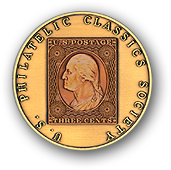The Hodziewich papers are shown courtesy of the Smithsonian’s National Postal Museum. They were found among the papers George Brett donated to the museum upon his death. Stanley J. Hodziewich worked for the U.S. Post Office Department. In the 1950s, he located a collection of original documents that were slated for destruction. After receiving permission, he removed the papers to his home. Much later, George Brett acquired them. George used them to write his essay “Updating the U.S. 1847’s on Their 150th Anniversary: Beginning, Production, Ending” in the 1997 Congress Book. The scans for the documents he referenced are on the museum’s web site “Arago”. The papers which are shown here cover later issues of postage stamps. Scholars using images and content from the Hodziewich Papers should credit: Smithsonian’s National Postal Museum.
Scope & Content
The material illustrated mostly consists of correspondence files of the Third Assistant Postmaster General spanning the period from 1851 to 1911. Until the introduction of the typewriter about 1885, the documents are handwritten. They have not been transcribed as the Travers Papers were.
Most of over a thousand pages of documents consist of, but are not limited to, communications between the Post Office Department and:
- Private companies that engraved and printed postage stamps;
- Private companies that produced stamped envelopes and postal cards;
- The Bureau of Engraving and Printing;
- U.S. postal administrations in Cuba, Porto Rico, The Philippines, and Hawaii.
There is extensive coverage of contract issues during this period. The Cuba and Philippine documents are largely orders for stamped envelopes.
Organization
Documents are arranged in sections (accessed via the icons at the top of this page) that match the general headings under which they were filed by the Third Assistant Postmaster General, e.g. stamps, stamped envelopes, postal administrations abroad, etc. Within each section, documents are arranged chronologically by the year and month in which a letter or telegram was written (in the pull-down menu under the intro text).
Because the Third Assistant PMG was dealing with so many correspondents, replies will seldom be found in close proximity to an original letter. In many cases a stream of correspondence can be established by the file number written in pencil in the letter’s upper left corner. In the absence of such numbers, letters can be linked using the context of a discussion.
The researcher will notice the inclusion of gray-paper file jackets. These were used to hold several documents on a similar piece of post office business and as a place for docketing. Docketing comments consists of dated, hand-written notes of actions taken subsequent to sending or receiving a letter, so any given jacket may span a period of days to months. They are usually filed under the date on which the correspondence originated.
Searching
Post Office Department Letters prior to 1885 were hand-written, so cannot be searched using standard optical character recognition. Post-1885 letters were OCR scanned and are searchable. However, since each letter is a separate file, and since most letters are only one or two pages, it is usually faster to simply read the letters.


